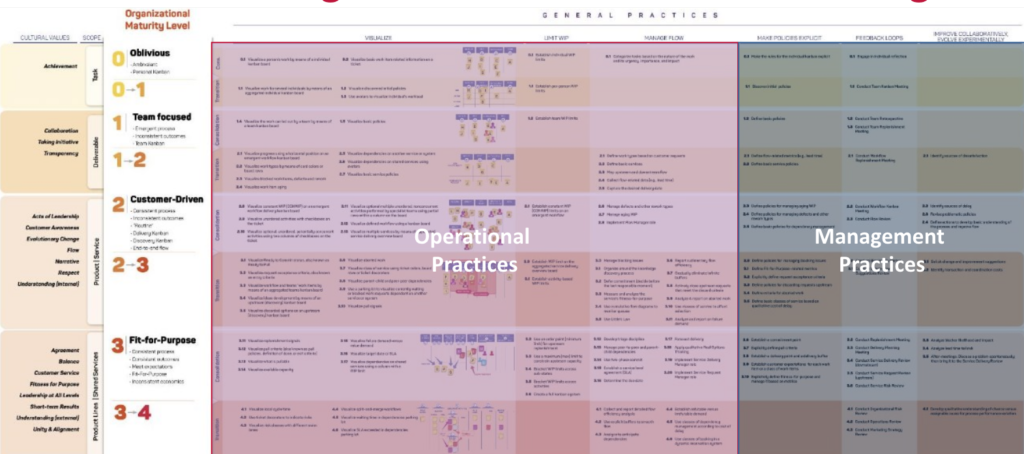Kanban Management Practices: Where the Real Value Lies
In my book, Discovering Kanban (Kanban University Press, 2023), I describe the six General Practices of the Kanban Method. Specifically, I divide these practices into two main groups: Operational Practices and Management Practices.
The Visible vs. Hidden Value of Kanban
You’ll often see the Operational Practices—Visualize Workflow, Limit Work in Progress (WIP), and Manage Flow—as the most visible aspects of Kanban. These practices show how to handle work from commitment to delivery. For many, these practices define Kanban. However, they often overlook the deeper value: Management Practices.
In contrast, Management Practices—Make Policies Explicit, Implement Feedback Loops, and Improve Collaboratively, Evolve Experimentally—drive evolutionary change. These practices help create a learning organization that continuously evolves and improves. Thus, they form the core of Kanban’s ability to drive ongoing improvement and organizational agility.

First-Generation Agility
The Operational Practices provide what we call first-generation agility. This type of agility allows organizations to respond quickly to new requests and deliver work efficiently. Although this represents a significant improvement for many, it only scratches the surface of what Kanban offers.
Second-Generation Agility
Kanban delivers organizational agility, not just project or product agility.
Kanban was designed to enable second-generation agility—a deeper capability to adapt to changing market conditions, customer needs, and economic shifts. Unlike first-generation agility, which focuses on adapting individual projects, second-generation agility involves evolving the entire service delivery system.
In their 2009 minibook, Scrum and Kanban: Making the Most of Both, Henrik Kniberg and Mathias Skarin defined Kanban with three visible practices: Visualize, Limit WIP, and Manage Flow. They compared Kanban to Scrum, focusing on its ability to adapt to changing requirements. Nevertheless, this narrow view missed Kanban’s full potential. They didn’t recognize Kanban’s capacity for evolutionary change, which makes it a true second-generation agility approach. Consequently, Kanban delivers organizational agility, not just project or product agility.
The Shift in Management Mindset
In my 2003 book, Agile Management for Software Engineering, I outlined the necessary shift in management practices. Specifically, I emphasized that managers should move from managing individual tasks and time to designing systems that manage work effectively. This shift involves thinking in systems to support Agile methodologies better.
Over the past 21 years, many managers have felt threatened by Agile methods, fearing that these approaches might replace them. This fear has led to resistance and slowed Agile adoption. Often, Agile methods were applied to teams without changing management behavior. This issue arose partly due to a lack of explicit guidance for managers.
Core Kanban Management Practices
Kanban’s Management Practices provide essential guidance for effective management:
- Make Policies Explicit: Clearly define the rules and guidelines of the system to ensure transparency and consistency.
- Implement Feedback Loops: Build systems that learn and adapt through regular feedback.
- Improve Collaboratively, Evolve Experimentally: Foster shared responsibility for improvements and use data-driven insights to drive change.
The Importance of Better Management
In Software Engineering Economics (1981), Barry Boehm highlighted that poor management can increase software costs faster than any other factor. This insight has guided my work for over 25 years. To improve technology and innovation, we must enhance management capabilities. Therefore, managers need to think in systems and create environments that support effective decision-making and successful outcomes.
The Kanban Method provides a framework that helps managers lead effectively in today’s complex work environment. By focusing on the Management Practices—Make Policies Explicit, Implement Feedback Loops, and Improve Collaboratively, Evolve Experimentally—Kanban supports organizations in achieving second-generation agility. These practices help organizations stay adaptable and resilient.
Discovering the True Value of Kanban
Although Kanban’s Operational Practices are widely available and relatively easy to learn, the real value lies in mastering the Management Practices. You can learn operational skills like visualizing workflows and limiting WIP through various resources. However, the true power of Kanban comes from understanding how to manage by thinking in systems.
Start with the Kanban System Improvement class, which is part of the Kanban Management Professional (KMP) credential, to learn these management practices. This class—and the advanced curriculum that follows—will enhance your leadership skills, help you scale practices, align strategy with capability, and support your development as a leader.
If you’re ready to advance your leadership skills and embrace second-generation agility, contact us for a free consultation. Let us help you define your next steps and begin your journey toward mastering Kanban.





